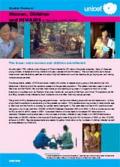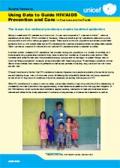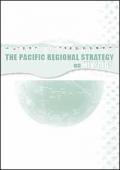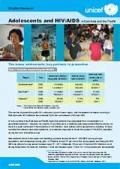What's New
Displaying results 4581 - 4590 of 4914

Resource | Publications,
HIV/AIDS is among the greatest health crisis ever faced by humanity. Already this pandemic has killed 20 million people. Today, 40 million people are living with HIV. Each year, 3 million are dying of HIV/AIDS. However, most of these deaths could be prevented if they had access to antiretroviral therapy (ART).
In September 2003, WHO declared that failure to provide antiretroviral therapy to patients in developing countries a global public health emergency. Accordingly, WHO with UNAIDS and partners set a target of providing 3 million people in developing countries with antiretroviral treatment by the end of 2005 (the “3 by 5” initiative). While this is an interim target, long-term goal is of universal access to ART for all those who need it.
The primary objective of the antiretroviral therapy is to prolong the survival as well as improve the quality of life of the people living with HIV/AIDS. By bringing down the HIV viral load to sustained undetectable level, it is expected that ART will contribute also to HIV prevention.

Resource | Tools,
This toolkit has been written for anyone that wants to know more about GIPA – the Greater Involvement of People Living with HIV and AIDS. It has been prepared by consultants working for the Asia-Pacific Network of People Living with HIV/AIDS (APN+), with support from the Asia-Pacific Council of AIDS Service Organisations (APCASO) and the Seven Sisters Coalition. With this toolkit, this consortium aims to convince you that GIPA is both important and possible and to provide practical steps to strengthen the involvement of people living with HIV in the creation and implementation of AIDS policy and programs. GIPA is not an end in itself; it is a tool to enable us to achieve our ultimate goals: improving the quality of life of all people living with HIV in this region and preventing further HIV infections.
The processes and workshop exercises outlined in this toolkit are written for PLWHA groups and networks and community-based organisations in Asia-Pacific. It can be easily adapted for use by governmental departments and international organisations, too. This is a resource document.

Resource | Publications,
An estimated 1,700 children under the age of 15 are infected by HIV around the globe everyday. Many of these are young children, infected at birth by mothers who are unaware of their HIV status. The number continues to rise as more women are infected by partners who adopt high risk behaviours such as injecting drugs, buying sex, and having multiple sexual partners.
One recognizable pattern of HIV transmission starts with sudden increases among groups that practice high-risk behaviours, following which the epidemic spreads to the general population. This pattern has been seen in parts of East Asia and the Pacific. Sex workers, their clients and/or injecting drug users no longer form the bulk of new infections in countries such as Thailand, Myanmar, Cambodia, and parts of Viet Nam and China. The epidemic profile is shifting towards wives infected by their husbands who are often their only sexual partners.

Resource | Publications,
Although overall adult HIV prevalence in Asia is low - 0.4 per cent compared to 7.4 per cent in Africa - national prevalence varies widely. Within countries of the region, there are disturbingly high prevalence rates among some sub-populations and within various geographic areas. These locations and sub-populations are where concentrated epidemics build up, with substantially higher HIV prevalence than national prevalence levels can adequately capture.
A marked, sudden increase of HIV prevalence has occurred among sub-populations in a number of countries, and those experiencing a generalized epidemic bring lessons about the importance of proactive, early actions. Often countries have acted too late when the prevalence among sub-populations has begun to spread through what is known as "bridge populations" or people closely associated with these sub-groups. These bridge populations include clients of sex workers, their wives and girlfriends as well as sex partners of injecting drug users and men who have sex with men.

Resource | Publications,
The Pacific Regional Strategy on HIV/AIDS (2004-2008) builds on a vision for the Pacific, where the spread and impact of HIV/AIDS is halted and reversed; where leaders are committed to leading the fight against HIV/AIDS; where people living with and affected by HIV are respected, cared for and have affordable access to treatment; and where all partners commit themselves to these collective aims with the spirit of compassion inherent in Pacific cultural and religious values. The goal of the strategy is to reduce the spread and impact of HIV/AIDS, while embracing people infected and affected by the virus.
The strategy provides a framework for national and regionally funded activities throughout the Pacific. It has three main purposes: to increase the capacity of the Pacific Island countries and territories to provide an effective and sustainable response to HIV/AIDS; to strengthen coordination, and mobilize resources and expertise; and to assist countries to achieve and report on their national and international targets for HIV/AIDS.

Resource | Publications,
People who buy and sell sex pose one of the high-risk behaviours for HIV exposure in Asia. It is therefore essential for HIV prevention interventions to take into account the nature of the Asian sex industry. The purpose of this booklet is twofold:
1. to summarize what researchers have learned about the epidemiology of HIV/AIDS within Asian commercial sex networks; and,
2. to discuss the programmatic implications of those findings.
This publication follows up by highlighting the points that relate specifically to the spread of HIV through commercial sex. It also describes how those points should inform HIV prevention strategies.

Resource | Tools,
It is now widely accepted that HIV/AIDS is a threat to social and economic development with serious implications not only for the health and well-being of individuals but also for productivity, economic development, the social fabric of communities and national security. HIV/AIDS therefore requires the full commitment of all sectors: public, private and civil society. What might an expanded response to HIV/AIDS, that extends beyond the health sector and calls for the mobilization of all societal resources to combat the disease, look like?
A multisectoral approach to HIV/AIDS aims at mobilizing resources – financial and otherwise. Sector-wide approaches provide opportunities for integrated responses to HIV/AIDS, moving away from the traditional vertical approach that addresses HIV/AIDS as a disease specific (biomedical) or a narrowly-defined problem rather than incorporating poverty, development, nutrition, education and other prevalent factors that may help drive the epidemic.

Resource | Publications,
HIV/AIDS has left virtually no country, rich or poor, untouched. The East Asia region is already witnessing some of the world’s fastest growing HIV epidemics. Progress has been made, and leaders are beginning to match words with action. Yet there is much more to be done. Children are the missing face of AIDS, and failure to take account of their critical needs – be it prevention, treatment or care – will undermine the region’s chance of reaching Millennium Development Goals.
The Global Campaign on Children and AIDS seeks to confront these challenges and renew the drive to meet the UNGASS targets as well as those made during the UN Special Session on Children in 2002. By forging a wide-ranging alliance with the governments, international and national partners, along with the civil society, and through leveraging resources, the campaign places children at the heart of the region’s HIV/AIDS response, and thus, contributes to East Asia’s efforts to scale up the response to HIV/AIDS.

Resource | Publications,
Many countries across the region have developed plans to address HIV/AIDS among young people. Prevention education and provision of youth-friendly health services are already stipulated in national strategies. However, programmes for institutionalized capacity building and sectoral policies in health, education, welfare, labour and social justice that are all vital to implementing and supporting this strategy remain few and far between.
Interventions focused on the most highly vulnerable young people are often said to be the key to slowing or halting the epidemic. However, capacity is clearly inadequate in many countries, and includes an insufficient availability of human and financial resources, as well as a lack of systematic tracking for behavioural trends and risks. Furthermore, social attitudes towards those most at risk, - who are usually already marginalized and discriminated against because of their behaviours, - remain obstacles which hamper effective preventive measures.

Resource | Publications,
HIV/AIDS is a significant public health problem in all three countries. In Cambodia HIV prevalence rates have fallen from 2.6% to 1.9% among adults aged 15-491, but remain among the highest in the region – with some 123,000 people living with HIV. In Vietnam, while national prevalence is still low, HIV has been reported in all provinces and is relatively high, over 10%, among sex workers and injecting drug users – two key high risk groups. In Laos prevalence is still very low, and is largely confined to the two larger cities (Vientiane and Savannakhet) – yet STD rates among service women are very high in a number of provinces, and Laos’ relatively porous borders with Thailand and Cambodia suggest significant vulnerability.
The goal of the Project was to reduce HIV transmission among mobile groups of people, migrants, and source and host communities in the three countries in order to decrease the impact of the HIV epidemic in the region.





